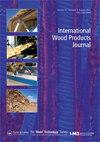The influence of helix angle of router bits on chip flow, roughness and noise level in milling different grain angle orientation of teak wood
IF 0.9
Q2 MATERIALS SCIENCE, PAPER & WOOD
引用次数: 1
Abstract
ABSTRACT This study was done to investigate surface roughness, noise level, chip shapes and chip flows characteristic in milling teak wood by conventional and helical router bits. Down-milling process compared to up-milling process produced better surface roughness, lower noise level, and flow chip. Better surface roughness (R a value) was produced by the router bits with higher helix angle compared to lower helix angle. Noise level decreased with increasing in the helix angle of the router bits. The increasing in the angle of the wood grain would increase the values of surface roughness and noise level. With increasing helix angle of the bits the amount of spiral and flow chips increased and granule chips were reduced. The investigations have clearly confirmed that the helical edge is considered to be a valuable design to improve upon the performance of the straight edge for wood milling applications.刨削钻头螺旋角对柚木不同粒度方向铣削时切屑流动、粗糙度和噪声水平的影响
摘要本研究旨在研究用常规和螺旋钻头铣削柚木时的表面粗糙度、噪声水平、切屑形状和切屑流动特性。与上铣削工艺相比,下铣削工艺产生了更好的表面粗糙度、更低的噪声水平和流动切屑。与较低的螺旋角相比,具有较高螺旋角的路由器钻头产生了更好的表面粗糙度(Ra值)。噪声水平随着路由器钻头螺旋角的增加而降低。木纹角度的增加会增加表面粗糙度和噪声水平的值。随着钻头螺旋角的增大,螺旋切屑和流动切屑的数量增加,颗粒切屑减少。研究清楚地证实,螺旋刃被认为是一种有价值的设计,可以提高木材铣削应用中直刃的性能。
本文章由计算机程序翻译,如有差异,请以英文原文为准。
求助全文
约1分钟内获得全文
求助全文
来源期刊

International Wood Products Journal
MATERIALS SCIENCE, PAPER & WOOD-
CiteScore
2.40
自引率
0.00%
发文量
27
 求助内容:
求助内容: 应助结果提醒方式:
应助结果提醒方式:


